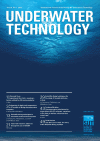
A determination of the propagation of electromagnetic waves through seawater
For the past four years detailed experiments have been carried out to investigate the propagation of electromagnetic (EM) waves between antennae in seawater in the MHz frequency range. The results have clearly shown that propagation is possible over a distance of 100m in a Liverpool
Dock for frequencies in the range 1 to 5MHz using a 30W amplifier. The existing water/air/water model of propagation cannot explain this result.
Therefore a theoretical model is given in this paper to explain the result and to give a generalised solution. It is based upon the generation of EM waves by dipole oscillations of the water molecules within the antenna electric field. The model has explained all the features observed in detailed experimental results obtained in tank experiments with both tap and salt water, whose conductivity varies between 0.1 and 4S/m, as well as in trials within Liverpool Dock. Within the tank the received signal in tap water increases with increasing frequency, whilst in salt water it decreases with increasing signal frequency. In general the signals in seawater are −55dB lower than in tap water. For each frequency the signal strength in seawater during propagation shows a rapid decrease in the vicinity of the transmitting antenna (near field) but only shows a slow decrease in the far field. The slow decay in the far field is attributed to a combined diffraction loss and an attenuation loss that increases with frequency. The result in the received signal exhibits a resonant effect in the frequency range 10 to 20MHz for propagation in seawater for a distance of 100m. Lower and higher MHz frequencies are difficult to propagate because the received signal strength is comparable with the background electrical noise within seawater (−135dBm) when a 30W signal is transmitted.
Therefore a theoretical model is given in this paper to explain the result and to give a generalised solution. It is based upon the generation of EM waves by dipole oscillations of the water molecules within the antenna electric field. The model has explained all the features observed in detailed experimental results obtained in tank experiments with both tap and salt water, whose conductivity varies between 0.1 and 4S/m, as well as in trials within Liverpool Dock. Within the tank the received signal in tap water increases with increasing frequency, whilst in salt water it decreases with increasing signal frequency. In general the signals in seawater are −55dB lower than in tap water. For each frequency the signal strength in seawater during propagation shows a rapid decrease in the vicinity of the transmitting antenna (near field) but only shows a slow decrease in the far field. The slow decay in the far field is attributed to a combined diffraction loss and an attenuation loss that increases with frequency. The result in the received signal exhibits a resonant effect in the frequency range 10 to 20MHz for propagation in seawater for a distance of 100m. Lower and higher MHz frequencies are difficult to propagate because the received signal strength is comparable with the background electrical noise within seawater (−135dBm) when a 30W signal is transmitted.
Keywords: DIELECTRIC DIPOLES; RF PROPAGATION; SUB-SEA ANTENNA; UNDERWATER COMMUNICATIONS
Document Type: Research Article
Publication date: 01 February 2007
- Underwater Technology is the peer-reviewed international journal of the Society for Underwater Technology. The objectives of the journal are to inform and acquaint the Society's members and other readers with current views and new developments in the broad areas of underwater technology, ocean science and offshore engineering.
- Editorial Board
- Information for Authors
- Submit a Paper
- Subscribe to this Title
- Membership Information
- Terms & Conditions
- Ingenta Connect is not responsible for the content or availability of external websites
- Access Key
- Free content
- Partial Free content
- New content
- Open access content
- Partial Open access content
- Subscribed content
- Partial Subscribed content
- Free trial content